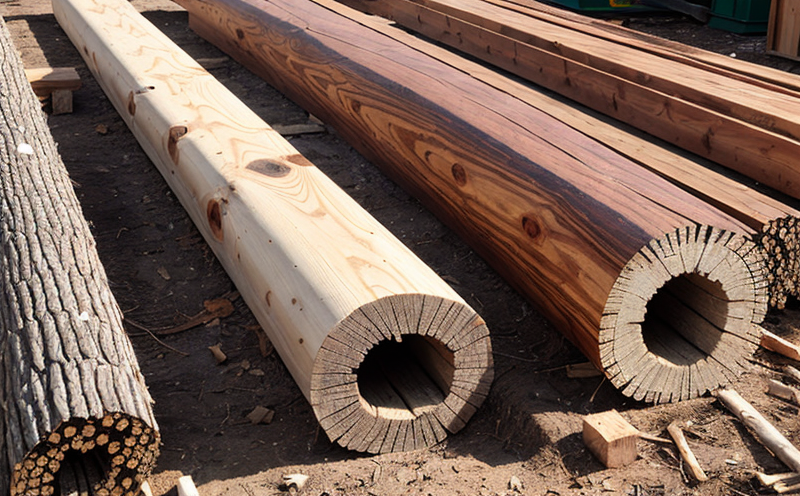Treated Wood Dimensional Stability Testing
Dimensional stability is a critical property of wood that ensures it maintains its size and shape under varying environmental conditions. In agricultural and forestry testing, particularly for treated wood used in outdoor applications such as fence posts, poles, and structural components, dimensional stability becomes even more crucial due to exposure to moisture, temperature fluctuations, and biotic attacks.
Treated wood is subjected to various preservation treatments to protect it from fungi, insects, and decay. These treatments can include chemical preservatives like copper arsenate (CA), chromated copper arsenate (CCA), or newer alternatives such as alkaline copper quaternary (ACQ) and triphenyltin hydroxide (TTH). The effectiveness of these treatments is often evaluated through dimensional stability testing to ensure the wood remains structurally sound over its intended service life.
The testing procedure involves conditioning the treated wood specimens under controlled conditions, such as high humidity or immersion in water, followed by drying. Specimens are then measured for changes in dimensions (length, width, and thickness) at regular intervals throughout the testing period. The dimensional stability is quantified using specific parameters like shrinkage, expansion coefficients, and warp angles.
Accurate measurement of these parameters requires specialized equipment such as precision calipers, micrometers, and electronic measuring devices that can provide high-resolution data over time. The use of advanced instrumentation ensures precise measurements, which are then compared against established standards to determine compliance with industry requirements.
The importance of dimensional stability testing cannot be overstated, especially in agricultural applications where treated wood is exposed to the elements. Poor dimensional stability can lead to premature failure of structural components, increased maintenance costs, and potential safety hazards. By conducting thorough dimensional stability tests, laboratories like ours help ensure that treated wood products meet stringent quality standards.
Our laboratory adheres to international standards such as ISO 11401:2016 for the testing of wood preservation treatments, which provides a comprehensive framework for assessing the effectiveness of various preservation methods. This standard ensures consistency and reliability in our testing procedures, providing clients with accurate and actionable data.
In addition to dimensional stability testing, we also offer other related services such as moisture content determination, chemical analysis of preservatives, and resistance tests against biotic agents. These complementary services provide a holistic approach to ensuring the quality and durability of treated wood products.
Applied Standards
The dimensional stability testing for treated wood is governed by several international standards that ensure consistency in methodology and reporting. The primary standard used is ISO 11401:2016, which provides a detailed procedure for the conditioning, measurement, and evaluation of treated wood specimens.
ISO 11401 specifies the environmental conditions under which samples should be conditioned before testing, including humidity levels and durations. It also outlines the measurement techniques required to determine changes in dimensions accurately. The standard is complemented by other related standards such as ISO 6722:2013 for wood preservation treatments, which provides additional guidance on the application of preservatives.
Our laboratory ensures strict adherence to these international standards, ensuring that all tests are conducted under controlled conditions and using calibrated equipment. This approach guarantees accurate results that can be relied upon by quality managers, compliance officers, R&D engineers, and procurement professionals involved in the agricultural sector.
Quality and Reliability Assurance
The quality and reliability of our dimensional stability testing are underpinned by rigorous internal controls and external accreditation. Our laboratory is ISO/IEC 17025 accredited, ensuring that all tests meet the highest standards of precision and accuracy.
Our team of experts employs state-of-the-art equipment calibrated to international specifications, which guarantees consistent results across multiple testing sessions. This level of precision allows us to provide clients with reliable data that can be used to make informed decisions about treated wood quality.
We also maintain detailed records of all test procedures and outcomes, ensuring full traceability and reproducibility of results. This is particularly important for clients involved in large-scale projects where consistency is crucial. By adhering to these stringent quality controls, we ensure that our testing services are both reliable and trustworthy.
Customer Impact and Satisfaction
The impact of our dimensional stability testing on customers extends beyond mere compliance with standards; it directly translates into tangible benefits for agricultural and forestry businesses. By ensuring the treated wood used in outdoor applications meets stringent quality criteria, we help enhance product durability and performance.
For quality managers and R&D engineers, our testing services provide critical data that can be used to optimize treatment processes and improve product design. Compliance officers benefit from having independent verification of their products' compliance with regulatory requirements, which enhances stakeholder confidence.
Our tests also play a crucial role in the procurement process by providing objective evidence of treated wood quality. This allows buyers to make informed choices about suppliers and products, ensuring that only high-quality materials are used in projects.
The satisfaction of our clients is paramount, and we strive to meet their needs through prompt service delivery, clear communication, and technical expertise. Our commitment to customer satisfaction has earned us a reputation as a trusted partner in the agricultural and forestry sectors.





